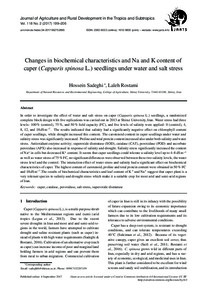Aufsatz

Changes in biochemical characteristics and Na and K content of caper (Capparis spinosa L.) seedlings under water and salt stress
Zusammenfassung
In order to investigate the effect of water and salt stress on caper (Capparis spinosa L.) seedlings, a randomized complete block design with five replications was carried out in 2013 at Shiraz University, Iran. Water stress had three levels: 100 % (control), 75 %, and 5 % field capacity (FC), and five levels of salinity were applied: 0 (control), 4, 8, 12, and 18 dSm^(−1). The results indicated that salinity had a significantly negative effect on chlorophyll content of caper seedlings, while drought increased this content. The carotenoid content in caper seedlings under water and salinity stress was significantly increased. Proline and total protein content increased also under both salinity and water stress. Antioxidant enzyme activity; superoxide dismutase (SOD), catalase (CAT), peroxidase (POD) and ascorbate peroxidase (APX) also increased in response of salinity and drought. Salinity stress significantly increased the content of Na^+ in cells but decreased K^+ content. It seems that caper seedlings could tolerate a salinity level up to 4–8 dSm^(−1) as well as water stress of 75 % FC, no significant differences were observed between these two salinity levels, the water stress level and the control. The interaction effect of water stress and salinity had a significant effect on biochemical characteristics of caper. The highest content of carotenoid, proline and total protein content were obtained in 50 % FC and 18 dSm^(−1).The results of biochemical characteristics and leaf content of K+ and Na+ suggest that caper plant is a very tolerant species to salinity and drought stress which make it a suitable crop for most arid and semi-arid regions of Iran.
Zitierform
In: Journal of Agriculture and Rural Development in the Tropics and Subtropics. Kassel : Kassel University Press. - Vol. 118, No. 2 (2017) S. 199-206Sammlung(en)
Vol 118, No 2 (2017) (Journal of Agriculture and Rural Development in the Tropics and Subtropics (JARTS))Zitieren
@article{urn:nbn:de:hebis:34-2017062752895,
author={Sadeghi, Hossein and Rostami, Laleh},
title={Changes in biochemical characteristics and Na and K content of caper (Capparis spinosa L.) seedlings under water and salt stress},
year={2017}
}
0500 Oax 0501 Text $btxt$2rdacontent 0502 Computermedien $bc$2rdacarrier 1100 2017$n2017 1500 1/eng 2050 ##0##urn:nbn:de:hebis:34-2017062752895 3000 Sadeghi, Hossein 3010 Rostami, Laleh 4000 Changes in biochemical characteristics and Na and K content of caper (Capparis spinosa L.) seedlings under water and salt stress / Sadeghi, Hossein 4030 4060 Online-Ressource 4085 ##0##=u http://nbn-resolving.de/urn:nbn:de:hebis:34-2017062752895=x R 4204 \$dAufsatz 4170 7136 ##0##urn:nbn:de:hebis:34-2017062752895
<resource xsi:schemaLocation="http://datacite.org/schema/kernel-2.2 http://schema.datacite.org/meta/kernel-2.2/metadata.xsd"> 2017-09-06T07:27:55Z 2017-09-06T07:27:55Z 2017-09-04 1612-9830 2363-6033 urn:nbn:de:hebis:34-2017062752895 http://hdl.handle.net/123456789/2017062752895 eng Kassel University Press Urheberrechtlich geschützt https://rightsstatements.org/page/InC/1.0/ caper catalase peroxidase salt stress superoxide dismutase 630 Changes in biochemical characteristics and Na and K content of caper (Capparis spinosa L.) seedlings under water and salt stress Aufsatz In order to investigate the effect of water and salt stress on caper (Capparis spinosa L.) seedlings, a randomized complete block design with five replications was carried out in 2013 at Shiraz University, Iran. Water stress had three levels: 100 % (control), 75 %, and 5 % field capacity (FC), and five levels of salinity were applied: 0 (control), 4, 8, 12, and 18 dSm^(−1). The results indicated that salinity had a significantly negative effect on chlorophyll content of caper seedlings, while drought increased this content. The carotenoid content in caper seedlings under water and salinity stress was significantly increased. Proline and total protein content increased also under both salinity and water stress. Antioxidant enzyme activity; superoxide dismutase (SOD), catalase (CAT), peroxidase (POD) and ascorbate peroxidase (APX) also increased in response of salinity and drought. Salinity stress significantly increased the content of Na^+ in cells but decreased K^+ content. It seems that caper seedlings could tolerate a salinity level up to 4–8 dSm^(−1) as well as water stress of 75 % FC, no significant differences were observed between these two salinity levels, the water stress level and the control. The interaction effect of water stress and salinity had a significant effect on biochemical characteristics of caper. The highest content of carotenoid, proline and total protein content were obtained in 50 % FC and 18 dSm^(−1).The results of biochemical characteristics and leaf content of K+ and Na+ suggest that caper plant is a very tolerant species to salinity and drought stress which make it a suitable crop for most arid and semi-arid regions of Iran. open access In: Journal of Agriculture and Rural Development in the Tropics and Subtropics. Kassel : Kassel University Press. - Vol. 118, No. 2 (2017) S. 199-206 Sadeghi, Hossein Rostami, Laleh Gedruckte Ausg. im Verlag Kassel Univ. Press (www.upress.uni-kassel.de) erschienen. </resource>
Die folgenden Lizenzbestimmungen sind mit dieser Ressource verbunden:
Urheberrechtlich geschützt

